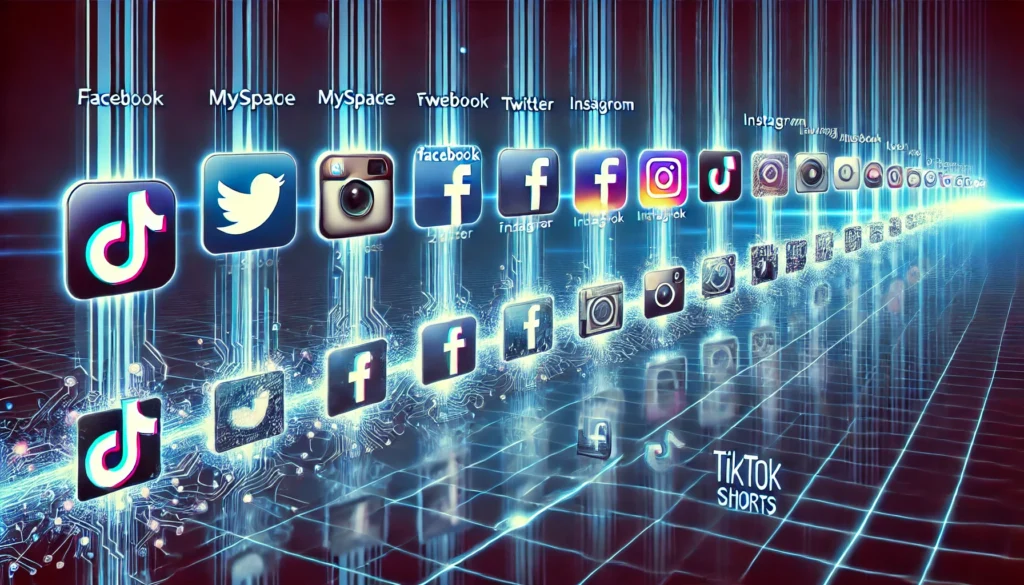The Evolution of Social Media: A Journey from Past to Future
Introduction
Social media has transformed from simple online forums to powerful platforms that shape global conversations, businesses, and personal interactions. What started as basic networking sites like MySpace and Friendster has evolved into AI-driven, video-centric platforms like TikTok and Instagram. Over the years, social media has changed how we communicate, consume information, and market products. With new advancements in AI, virtual reality, and decentralized networks, the future of social media promises even more innovation. In this article, we’ll explore the journey of social media evolution and what lies ahead.
1. The Early Days: The Birth of Online Networking (1990s – Early 2000s)
Before Facebook, Instagram, and TikTok, there were simple online communities where people connected based on shared interests.
Key Platforms & Trends:
Six Degrees (1997): The first real social networking site, allowing users to create profiles and connect with others.
Friendster (2002): Focused on expanding your network through friends of friends.
MySpace (2003): Allowed users to customize profiles, upload music, and interact with friends, making it a major player before Facebook took over.
What Was Different?
Early social media was text-heavy and focused more on personal networking.
No advanced algorithms—content appeared in chronological order.
Limited business use; social media was mainly for fun and personal connections.

2. The Rise of Facebook, Twitter, and Instagram (2004-2015)
The mid-2000s to early 2010s marked a major shift in how social media worked. Platforms started focusing on user-generated content, real-time updates, and engagement.
Key Milestones:
Facebook (2004): Started as a college networking site but soon became the biggest social platform globally. Features like the News Feed, Groups, and Business Pages made it a central hub for social interaction.
Twitter (2006): Introduced microblogging, allowing users to share short, real-time updates (tweets). It became the go-to platform for breaking news and trends.
Instagram (2010): Shifted focus from text to visuals, encouraging users to share high-quality images and later videos.
LinkedIn (2003): Became the leading platform for professionals and businesses.
The Big Changes:
Algorithms started playing a bigger role, deciding what content people saw.
Businesses started using social media for marketing, branding, and
3. The Era of Video and Short-Form Content (2016-Present)
The mid-2010s saw the explosion of video content, with users preferring short, engaging videos over text or static images.
Key Trends & Platforms:
Snapchat (2011) & Instagram Stories (2016): Popularized short-lived content (disappearing photos and videos).
TikTok (2018): Changed the game with its short-form videos and AI-driven content recommendations.
YouTube Shorts, Instagram Reels, and Facebook Watch: Major platforms adapted to the short-video trend.
Why Did Short Videos Take Over?
People’s attention spans became shorter.
Videos are more engaging and easier to consume than text.
AI-powered recommendations make content highly personalized and addictive.

Live Streaming Boom
Live videos became a huge part of social media, with businesses, influencers, and even politicians using them to interact directly with their audiences. Platforms like Facebook Live, Instagram Live, and Twitch made real-time engagement easier than ever.
4. The Future of Social Media: What’s Next?AI
Social media is constantly evolving. So, what will it look like in the next 5-10 years?
AI & Automation Will Take Over
AI will personalize content even more, showing users only what they’re most interested in.
AI chatbots will become smarter, handling customer service, sales, and social interactions for businesses.
Content creation will also be AI-powered, helping brands generate text, images, and videos effortlessly.
Decentralized Social Media & Web3
Platforms like Bluesky and Mastodon are promoting decentralized social media, where users have more control over their data.
Blockchain technology will make it easier to monetize content without relying on ads.
Virtual Reality (VR) & Augmented Reality (AR)
The Metaverse: Platforms like Meta (formerly Facebook) are working on creating virtual spaces where people can socialize, work, and shop.
AR filters and virtual try-ons will become even more common in social media marketing.
More Focus on Privacy & Data Protection
Users are becoming more aware of data privacy issues, forcing platforms to be more transparent about how they use personal information.
Stricter regulations (like GDPR and new US data laws) will change how social media platforms handle user data.

5. How Businesses & Content Creators Can Adapt
With so many changes happening, how can businesses and content creators stay relevant?
1. Focus on Video Content
Short videos are the future—use TikTok, Reels, a4.
Live streaming is great for real-time engagement with audiences.
2. Embrace AI & Automation
Use AI tools to automate content scheduling and engagement.
AI-generated content can help save time but should still have a human touch.
3. Build Authentic Connections
User-generated content (UGC) builds trust—encourage followers to create and share content about your brand.
Be real and relatable—audiences engage more with brands that feel human.
4.Adapt to New Social Media Trends Quickly
Stay updated with algorithm changes and new features.
Experiment with new platforms like decentralized social media or AR-based marketing.
Conclusion
Social media has transformed from simple networking sites to powerful platforms that shape culture, politics, and business. From MySpace and Facebook to TikTok and the Metaverse, the journey of social media evolution has been exciting—and it’s far from over.
To stay ahead, individuals and businesses must embrace new trends, adapt to changing algorithms, and focus on authentic engagement. The future of social media will be driven by AI, short-form content, and new technologies, making it an exciting space to watch
